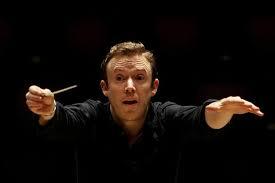by Paul J. Pelkonen

Conductor Daniel Harding brought the Royal Concertgebouw Orchestra
in for a landing at Carnegie Hall on Thursday night. Photo © 2017 The Lucerne Festival.
The Royal Concertgebouw Orchestra is the most famous musical export from the Netherlands. On Thursday night, the ensemble returned to Carnegie Hall for its first New York concerts since the ouster of conductor Daniele Gatti, who was released from his contract in August of 2018 following accusations of inappropriate sexual behavior. (Mr. Gatti is reportedly planning to sue.) His replacement for this North American tour is Daniel Harding, an Englishman who is not well known on American podiums, although he has worked at the Metropolitan Opera and led the New York Philharmonic in a memorable run of concerts in 2011.
For the first work on the program, Mr. Harding and the Dutch players were temporarily fused with members of the National Youth Orchestra, a teaching ensemble sponsored by Carnegie Hall. Their task: to perform Schumann's Manfred Overture. And so the second team filed in, all wearing large white pins on their lapels, settling at desks next to the Concertgebouw members. Mr. Harding entered, also sporting a large NYO pin, and the concert started.
The results were what you'd expect from the sudden blending of two orchestras, decidedly mixed. The players from both teams sounded tentative in this unfamiliar music, and their efforts, while of a professional grade felt wooden and rote. Granted, there is a need for better music education in this country, and the opportunity for these young musicians to work alongside veterans is perhaps once in a lifetime. However, one wonders if the audience too saw the same value in this underwhelming performance.
The Mozart Symphony No. 40 in G minor followed. One of the composer's most original scores, it was beset by odd tempos and sudden shifts in phrasing. In particular, a climactic upward staccato phrase was played as a slur of notes, robbing the music of its dramatic effect. Mr. Harding repeated this questionable interpretation at the recapitulation to diminishing effect. The remainder of the performance was played with beautiful tone but a curious lack of involvement from musicians and maestro.
The problems in the first half were in sharp contrast to the second, a finely drawn and detailed performance of Brahms' Symphony No. 4. This is the last, the densest and the most radical of the composer's four symphonies, in which the composer looks back to the Bach style while at once writing the real music of the future. Each movement is not what it appears, and the musical ideas come thick ad fast, often in the Brahmsian vertical organization that points the way forward to the works of Schoenberg, Webern and Berg.
Mr. Harding showed from the first phrase that he knew what he was about. The entire first movement is organized as an elaborate series of variations on the sighing interval that opens the work. And just for fun, Brahms organizes his sets of variations using sonata form, the traditional idea that served as the backbone of so-called "classical" music structure. Conductor and orchestra breathed life into all this dusty musicology, presenting a composer at the height of his inspiration, building whole castles of sound from those two simple opening notes.
The later movements are familiar but equally wild in their invention. A sonorous horn call led off the Andante moderato, echoed by the woodwinds who subsided into a quiet chorus of comment over plucked strings. Mr. Harding took this at a moderate walk, leading the listener forward to eloquent solo passages for the clarinet and a gentler song from the horns. The third movement is fast but unlike any scherzo, it is not so much a dance as a riot of ideas that sound like church musicians at play on a massive pipe organ. The finale is the oddest duck of all: another enormous structure built from a chaconne. This is an old fashioned (18th century) dance meter that springboards a general celebration of the life of the heart and the mind. ere at last was the orchestra that the audience had come to see, in glorious form.
If you enjoyed this article, it's time to click over to Superconductor's Patreon page, and help support the cost of independent music journalism in New York City at the low cost of just $5/month.<br />

